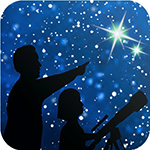Fall and winter months bring longer nights, and with these earlier evenings, even the youngest astronomers can get stargazing. One of the handiest things you can teach a new astronomer is how to measure the sky – and if you haven’t yet learned yourself, it’s easier than you think!
Weird Ways to Observe the Moon
International Observe the Moon Night is on October 16 this year– but you can observe the Moon whenever it’s up, day or night! While binoculars and telescopes certainly reveal incredible details of our neighbor’s surface, bringing out dark seas, bright craters, and numerous odd fissures and cracks, these tools are not the only way to observe details about our Moon. There are more ways to observe the Moon than you might expect, just using common household materials.
Catch Andromeda Rising
If you’re thinking of a galaxy, the image in your head is probably the Andromeda Galaxy! Studies of this massive neighboring galaxy, also called M31, have played an incredibly important role in shaping modern astronomy. As a bonus for stargazers, the Andromeda Galaxy is also a beautiful sight.
Corner the Great Square of Pegasus
The Summer Triangle may be the most famous seasonal star pattern, but during early August evenings another geometrically-themed asterism rises: the Great Square of Pegasus. This asterism’s name is a bit misleading: while three of its stars – Scheat, Markab, and Algenib – are indeed found in the constellation of the winged horse Pegasus, its fourth star, Alpheratz, is the brightest star in the constellation Andromeda!
Observe the Milky Way and Great Rift
Summer skies bring glorious views of our own Milky Way galaxy to observers blessed with dark skies. For many city dwellers, their first sight of the Milky Way comes during trips to rural areas – so if you are traveling away from city lights, do yourself a favor and look up!
Astrophotography With Your Smartphone
Have you ever wanted to take night time photos like you’ve seen online, with the Milky Way stretched across the sky, a blood-red Moon during a total eclipse, or a colorful nebula? Many astrophotos take hours of time, expensive equipment, and travel, which can intimidate beginners to astrophotography. However, anyone with a camera can take astrophotos; even if you have a just smartphone, you can do astrophotography. Seriously!
Virgo’s Galactic Harvest
May is a good month for fans of galaxies, since the constellation Virgo is up after sunset and for most of the night, following Leo across the night sky. Featured in some ancient societies as a goddess of agriculture and fertility, Virgo offers a bounty of galaxies as its celestial harvest for curious stargazers and professional astronomers alike.
Watch the Lion: Celestial Wonders in Leo
Leo is a prominent sight for stargazers in April. Its famous sickle, punctuated by the bright star Regulus, draws many a beginning stargazer’s eyes, inviting deeper looks into some of Leo’s celestial delights, including a great double star and a famous galactic trio.
Taking the Dog Stars for a Springtime Walk: Sirius and Procyon
March skies feature many dazzling stars and constellations, glimmering high in the night, but two of the brightest stars are the focus of our attention this month: Sirius and Procyon, the dog stars!
Landing On Mars: A Tricky Feat!
The Perseverance rover and Ingenuity helicopter will land in Mars’s Jezero crater on February 18, 2021, NASA’s latest mission to explore the red planet. Landing on Mars is an incredibly difficult feat that has challenged engineers for decades: while missions like Curiosity have succeeded, its surface is littered with the wreckage of many failures as well. Why is landing on Mars so difficult?

